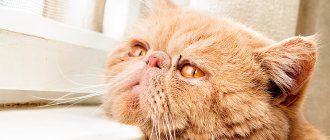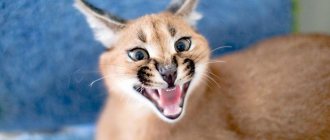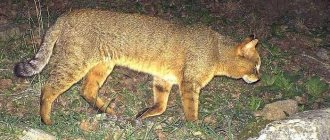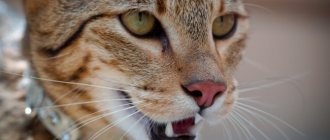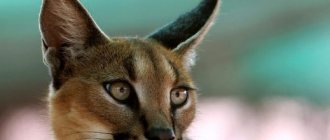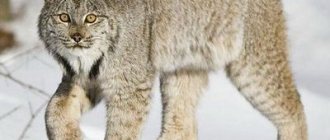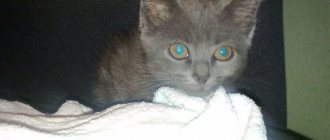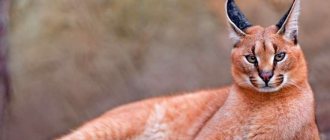The Amur forest cat (Prionailurus bengalensis euptilurus) belongs to the subspecies of the Bengal cat. It is considered a relative of the Amur tiger and the Far Eastern leopard. However, unlike its brothers, the Far Eastern cat was undeservedly deprived of attention.
Amur forest cat: description of the species
Cold indifference to this harmless animal has led to disappointing consequences - now the Amur cat is listed in the Red Book as an endangered subspecies. Thanks to the efforts of animal rights activists, in recent years the situation has leveled out - the population size is gradually increasing.
Habitat
The Amur cat settled along the shores of the Sea of Japan and near the Amur basin. In addition to Russia, the Far Eastern cat is common in China, Japan and the Korean Peninsula, inhabiting the entire space from Hindustan to the Malay Archipelago.
Amur cat in Primorsky Krai
Since the area inhabited by the Amur cat is large and climatically heterogeneous, the habits of wild cats from different regions may differ from each other. In particular, the habitat affects the breeding periods and the mass of cats.
Amur cats are happy to explore the steppe
The tropical orientation of the Far Eastern cat suggests that impenetrable forests are not the best place for animals like him. However, circumstances were such that the Amur cat emigrated to the snowy Ussuri region and remained to live there forever.
Number
It may seem strange, but there is no exact data on the number of forest Amur cats. They are so secretive that it is not possible to make even an approximate count. However, they are currently listed in the Red Book as an endangered species.
The reason for this was not hunting, as it might seem, but the loss of places suitable for habitation. Every year there are fewer and fewer isolated forests or lowlands not plowed for fields. The annual “burnings” - burning of last year’s leaves and fallen branches - also pose a huge danger to forest inhabitants.
Fortunately for the Far Eastern cat, it cannot boast of particularly valuable fur, and in Russia it was never hunted as a fur-bearing animal. But in China, the “Money” predator was killed for a long time precisely for the sake of fur. Now hunting for it is prohibited, and it is included in the list of animals protected by law.
Appearance
The weight of an adult Amur cat varies from 4 to 7 kg; there are also particularly large specimens weighing up to 15 kg. The body length of the cat reaches 75-90 cm, the tail of representatives of the subspecies reaches 40 cm in size.
Some wild cats are smaller in size than domestic cats. The size of Far Eastern cats depends on both location and time of year. In the summer, thanks to the diligent accumulation of fat, the leopard cat weighs significantly more than in the winter, when it wastes the energy reserves acquired over the summer.
Table 1. Exterior of the Amur forest cat
| Part of the body | Description |
| Head Eyes Ears Nose Jaws | Small in size, has an elongated shape Deep-set, oval in shape, located at a short distance from each other Rounded, slightly oblong, without tassels at the ends, mobile Large, gray-red in color. On the nose there is a wide bare stripe without hair Equipped with sharp fangs, the upper fangs are long and thick |
| Limbs Claws | Medium length, with small claws Short, strong, easily retracted into the paws |
| Tail Tip of the tail | Long, thin, equal to half the length of the body, covered with dense and fluffy fur Black or dark gray, no tassel |
Sharp fangs allow wild cats to cope with even the toughest meat
Color
The color of the Far Eastern cat was formed in inextricable connection with the pragmatic function. In summer, when the sun is high, the dense leafy crowns scatter glare everywhere. The resulting play of light and shadow became the prototype for the stripes decorating the face of a wild cat. In the iridescent rays of the sun, the color of the animal maneuvering between the trees provides reliable camouflage. The predator is unlikely to figure out whether it is a wild cat running or just a flickering shadow from the branches. All representatives of the subspecies, without exception, have such stripes. This color arose as a result of adaptation to the environment - the mixed Ussuri taiga.
Blending into the background is the main function of a wild cat’s bizarre color
The number of spots on an Amur cat is an indicator of age. The younger the cat, the fewer spots cover its fur. The spots can be either clear or blurry. It was for these dark red circles that the forest cat was nicknamed “money” by the Japanese - these spots were very much like ancient Japanese coins in their minds. In young individuals, the leopard print coloring is more pronounced. Over the years, the color becomes less contrasting, tending towards uniformity.
Kittens have the most vibrant colors
In general, the color of the Far Eastern forest cat is so heterogeneous that for clarity it makes sense to resort to a schematic description:
Table 2. Color of the Amur forest cat
| Part of the body | Color |
| Head | Two white stripes run parallel from the inner corners of the eyes up the forehead and further along the crown of the head. |
| Chin | Almost white |
| Throat | Four to five rusty-brown transverse stripes |
| Back | Three brown stripes formed by elongated narrow spots. Sometimes they merge into one wide belt |
| Sides and lower body | Always several shades lighter than the back |
| Stomach | Off white with yellow undertones |
| Front legs | Cross stripes |
| Tail | Dark gray, sometimes one-color, more often it has up to seven black-gray incomplete rings. The tip of the tail is pure black or dark gray |
Fur
The fur of the Amur cat reaches five centimeters in length, which is why the animal reminds many of a plush toy. But first impressions are deceiving. The color of the coat can vary from gray-yellow to gray-brown. Fortunately for the leopard cat, its fur is not particularly valuable: as a fur-bearing animal, it does not attract hunters.
Despite the thick, warm fur, snow is not the Amur cat's best friend
In winter, wild cats have lighter and thicker fur, which prevents hypothermia. Far Eastern cats shed twice a year - in spring and autumn.
Description. Breed standard
The photo of forest cats presents us with an animal similar to ordinary gray domestic pets.
However, they have a larger body, reaching 4–8 kg. Under natural conditions, their weight depends on the season, availability of prey and age. An old cat in winter will weigh several times less than a well-fed young cat in the warm season. Weight ranges from 2.5–5.9 kg for females and from 3.5–8 kg for males. Moreover, a wild forest cat is inferior in size and weight to individuals living in captivity, especially if they have been castrated or sterilized. The body dimensions of this cat breed are as follows:
- females are approximately 75–80 cm long and 40 cm high at the withers;
- males reach a length of 90 cm and a height of up to 43 cm.
The forest cat lives quite a long time, up to 15 years in the natural environment and up to 30 years at home, in captivity. This period exceeds the life expectancy of ordinary cats.
In appearance, at first glance, a wild European cat is difficult to distinguish from a domestic one. Taking a closer look, discrepancies become noticeable. So, a forest dweller’s tail has a blunt end, it is shorter than that of a domestic cat, and fluffier. The shedding of a wild animal is more noticeable: in winter its fur is uniform, thick, fluffy and shiny. Shedding occurs in spring until May, in autumn until November. The track of a forest cat is identical to that of a domestic cat, but is slightly larger. The hind paws have four toes, the front paws have five. Sharp claws retract.
The forest cat has medium-sized, wide-set ears. The ears do not have tassels and can rotate to identify the direction of sound. The vision is stereoscopic, there are no eyelashes. Yellow-green eyes have a third eyelid - a nictitating membrane that performs a protective function. Forest animals have well-developed vision and hearing, while their sense of smell is slightly weaker. The teeth are sharp and small.
A wild cat makes sounds and screams similar to the screams of domestic pets, usually during mating periods; the rest of the time it is silent. But at the moment of aggression or attack, she can hiss, howl and whistle. The main enemies of forest cats are lynx, fox, marten, jungle cat, wolf and jackal, hawk and owl.
For habitat, the forest cat prefers:
- mixed and broad-leaved forests (chooses remote areas, climbs trees well);
- rocky and rocky areas of mountains (rises to heights of 3000 m above sea level);
- near rivers it settles in reed thickets.
In nature, the predatory forest cat feeds on small animals (hares, shrews, rabbits and moles), rodents (rats, nutria, mice, muskrats, voles), fish, lizards and snakes. He will not refuse plant food - leaves of some plants. Does not disdain mollusks, insects and crayfish. It can easily cope with ermine, weasel, marten and ferret. Of the larger animals, it attacks roe deer or chamois calves left without parental care.
Population status
Currently, the Amur forest cat is included in the Red Book. The exact number of cats of this subspecies is unknown today. According to rough estimates, it does not exceed two and a half to three thousand individuals.
According to the generally accepted point of view, the number of Amur cats has decreased by at least a third. Part of the responsibility for the sharp decline in wild cats lies with humans themselves, as they are involved in:
- plowing virgin soil;
- cutting down bushes;
- setting fire to stakes (small forests in the fields).
Many representatives of the subspecies fell into hunting traps and snares, originally intended for hares. Uncontrolled natural fires also played a destructive role.
By the way! During the Soviet era, the forest cat was considered an enemy of man, along with the wolf and lynx. For the capture and killing of wild cats, the village council provided a reward, which led to an increase in those wishing to exterminate the harmless cat.
All the negative factors described above led to the fact that in 2015 there were only a few thousand Amur forest cats.
Prevention of extermination
Thanks to the efforts of animal rights activists, a significant fine was introduced for the destruction of Amur cats, reaching several thousand rubles. In the near future, it is planned to systematically inform local residents, especially hunters, about rare representatives of the local fauna, as well as about the usefulness of wild cats in the fight against rodents. Also, Far Eastern cats are under vigilant supervision in Japan, where about fifty representatives of the subspecies live.
Reserves
It is difficult to overestimate the contribution of protected areas in the regions, which provide greater safety for animals. The list of such territories includes
- Land of the Leopard National Park;
- Kedrovaya Pad Nature Reserve;
- Bolshekhehtsirsky Nature Reserve;
- Lazovsky Reserve;
- Khanka Nature Reserve;
- Ussuri Nature Reserve.
Zoos
The Far Eastern leopard cat is a rare guest in zoos. It is mainly kept in zoos in China and Japan, but in Russia there are several places where this animal lives, for example, the Barnaul Zoo.
They say that Amur cats do not live in zoos, but simply die for a long time
There are several reasons for such a low prevalence of the Amur cat. Firstly, catching a wild cat specifically for collection is not an easy task. That is why the Amur cat was and remains one of the most poorly studied subspecies.
Secondly, leopard cats languish in captivity. Even in a zoo, where no one and nothing threatens the cat, the wild animal remains wild and extremely cautious. As a rule, he builds a hole for himself or uses an already prepared one, only occasionally coming into contact with people and other inhabitants.
When surrounded by people and other animals, cats remain withdrawn and cautious.
Despite the unadaptability of wild cats to life in a cage, in zoos and enclosures the life expectancy of representatives of the subspecies is 17-18 years, while in the wild they are given 10-12 years. However, there are a variety of assumptions about the number of years allotted to a forest cat by nature. Some argue that 18 years is not the limit.
Accommodation during freezing temperatures
When severe frost sets in, it begins to descend to human habitats to hunt rodents in dilapidated buildings. When it senses danger, it hides in the treetops. Finds refuge in large tree hollows and among rock crevices overgrown with bushes. Does not disdain old badger and fox holes. For convenience, leaves and dry grass are placed in the hollow. It climbs trees and rocks very well and can swim. The Amur forest cat arranges several secluded places on its territory, where it systematically enters. In winter, it hides in one of the most convenient lairs.
Amur cat in the wild
Despite the dangers that await the animal at every step, the leopard cat is deservedly considered a long-liver among cats. Perhaps the secret of the Amur cat's longevity is its specific measured rhythm of life and phlegmatic temperament.
The proverb “The slower you go, the further you will go” can be considered the motto of the Far Eastern wild cat
The Amur cat is least likely to be in a hurry. In winter, his metabolism and heart rate slow down. During cold weather, life seems to freeze for a wild cat, which extends the number of days allotted to it.
The furry animal lives in all suitable areas - in broad-leaved and coniferous forests, in the steppe, on the banks of lakes and rivers.
Lifestyle
Far Eastern forest cats are avid loners. It is very rare to notice them in someone's company. The cases when leopard cats can be found in pairs can be counted on the fingers of one hand. Otherwise, these self-sufficient animals live and hunt in complete solitude.
Amur cats form groups only during the mating season
The Ussuri taiga is unofficially divided by leopard cats into “fiefdoms” with an area of approximately 9-10 km2 - each with its own owner. The size of each Amur cat's personal territory depends on the abundance of prey.
The leopard cat is very attached to a specific area and is faithful to its habitat. He does not leave his territory even when faced with great danger.
Having once taken its place, the Amur cat will never want to leave it.
In the spring, during the mating season, Far Eastern cats remember that they are not alone in the universe, and begin to look for a mate. On such days, the quiet, thoughtful forest is filled with the abrupt roars of males looking for mates. Often, in the process of searching, they come close to nearby settlements and even enter them.
By the way! Roar is the only sound that can be heard from the Far Eastern cat. In other cases, the cat prefers to hiss, but does not do this often - only in case of a direct threat.
The hiss made by a leopard cat is almost inaudible to the human ear.
Video - Life of an Amur cat in the harsh taiga
Reproduction
The mating season directly depends on the territory in which the Far Eastern cat lives. For the northern regions, mating activity occurs at the end of February and throughout March, while for the southern regions there is no season limit.
Females bear kittens for 9-10 weeks, producing up to four kittens by early summer. The optimal number of cubs in a litter is one or two individuals.
The eyes of Amur kittens have a deep blue tint, which later disappears
Far Eastern cats can rightfully be called excellent parents. Females carefully guard the kittens, periodically moving them to a new place at the slightest hint of danger.
Even in a safe home environment, the cat never stops hiding her kittens in safe places.
Males take part in feeding the young on an equal basis with females. The duration of guardianship can extend up to six months.
Amur cat protects her kittens
In rare cases, primiparous females feel anxious and ignore their young. There have been situations in which domestic cats took abandoned wild kittens under their care.
The domestic cat shows care for Amur kittens just like her own
Growing up
The cubs are born blind and unadapted to independent life. Their eyes open on the tenth day. Kittens begin to explore nearby territories at two months, gradually leaving the den.
Kittens discover their indefatigable explorers early on.
After six months, they are already independent enough to leave the “parental home” and set up their own area for hunting and recreation. Far Eastern cats become fully mature, according to various estimates, in a year and a half.
Hybridization
In the spring, leopard cats do not disdain domestic cats, as a result of which many hybrids are born. Kittens, which are a cross between domestic and wild individuals, do not become tame, and, inheriting the genes of their father, rush into the forest. A domestic way of life cannot be forcibly instilled in these little savages.
Hybrid of Amur and Bengal individuals
The attitude towards such half-breeds is ambivalent. Some experts believe that such kittens pose a danger to the Amur cats themselves. The reason is that the hybrids themselves later mate with true forest wild cats, and subsequent offspring move further and further away from their original roots. If the situation does not change, the Amur cat will sooner or later face a real threat of extinction.
By the way! When crossing wild individuals with domesticated relatives, an interesting pattern was revealed: males born in this unequal union turned out to be infertile, while cats could have offspring.
Second generation of hybrid individuals
Scientists at the Institute of Cytology and Genetics of the Siberian Branch of the Russian Academy of Sciences, on the contrary, are confident that interspecific crossing will help Amur cats increase their numbers and disappear forever from the Red Book. However, they do not propose to leave the spontaneous March crossing of cats as is. According to experts, it is necessary to control mating between domestic and wild individuals using artificial insemination (IVF). At the moment, experiments are ongoing.
Main Enemies
The life of a forest cat can hardly be called simple. In the snowy forests of the taiga he is surrounded by many enemies - wolves, golden eagles, owls, eagle owls. The sable even happily eats blind defenseless kittens, scooping them out of their nests. It is not surprising that, surrounded by such dangerous predators, the Amur cat quickly learned caution, which became one of its characteristic traits.
Agile tree climbing allows the wild cat to avoid many encounters with predators
Even those representatives of the fauna that are its potential dinner can emerge victorious from a fight with a forest cat. For example, martens and ferrets are powerful opponents. Any mistake in a decisive battle can result in death for the Amur cat. Hunting dogs also show hostility towards wild cats and pose a significant threat to them.
Hunting
Amur cats are natural and successful hunters. Prey caught can range from small rodents to rabbits and roe deer. Not every dog dares to challenge a wild cat. The advantage of a leopard cat, like wild cats in general, is that it can hunt not only horizontally, but also vertically.
You can't hide from a forest cat either on the ground or in a tree
Wild cats have mastered trees perfectly, and therefore pose a danger not only on the ground. Overtaking a gaping jay and destroying a nest with chicks is a trifle for these dexterous animals. As for the rest, Far Eastern cats clearly prefer conservation to energy consumption. Just as they prefer waiting and ambush to direct confrontation. This quality is perfectly reflected in their habit of overtaking prey in one jump.
Strategist Skills
If necessary, there is no doubt that the cat will show its best side and emerge victorious even from a fight with an enemy to which it is inferior in both size and strength. It’s not for nothing that many hunters note that they would prefer to meet a lynx than this furry animal. But the furry animal will not rush headlong into a superior enemy.
The leopard cat knows a lot about calculating the prey's moves in advance.
The Amur cat is, first of all, a strategist. He knows how to wait and knows the value of time. Therefore, the battle with the Amur cat is not least a battle of intellects. The leopard cat prefers waiting in ambush to open confrontation, assuming that the prey will come on its own. In many cases, the cat's calculations turn out to be correct.
During the hunt, wild cats do not allow unnecessary movements
Housing
By arranging a bed for himself, the forest cat again proves himself to be a competent analyst, calculating the predator’s moves in advance. As a home, Amur cats prefer snow-covered windbreaks, which not every animal dares to enter. If someone is lucky enough to get to the Far Eastern cat, then catching it without twisting its limbs is an almost impossible task.
Not everyone can get to the Amur cat’s home
A wild cat is too smart to stop at one hiding spot. He usually constructs several tactically important points, between which he moves to make the predator’s task even more difficult. The leopard cat does not disdain burrows left by other animals. Sometimes the choice of forest cats falls on rock crevices. When frost strikes, the Amur cat chooses the most protected place and spends the winter there.
Migration
The Far Eastern forest cat is a tireless traveler. The frequent change of places is not groundless: each new home is explained by the greater security with which the leopard cat seeks to surround itself.
Every movement over a long distance is calculated in advance by a wild cat.
Before the snow falls, the Amur cat must move to areas densely covered with dense bushes in order to subsequently lie down under it. It is in the area of dense thickets that the snow is compacted as much as possible, creating a real impregnable “ice fortress” with branches in the form of a frame.
When the frost reaches a critical level, wild cats rush to the villages. It is at such moments that people most often catch them. Cats are attracted to old barns, sheds and other abandoned buildings because they are infested with rodents. In warmer seasons, the Amur cat prefers a variety of forest edges, meadows with tall, dense grass, and the banks of reservoirs.
The Amur cat feels safe among the tall reeds
Activity hours
Given the extreme caution and control over the situation characteristic of forest cats, it is almost impossible to see them during the day while walking. Amur cats are crepuscular animals, preferring the cover of night to the light of day. Spending the entire day in its secluded spot, the wild cat waits until sunset to hunt, remaining as undetected as possible.
Wild cats avoid hunting in sunlight if possible.
Nutrition
In harsh winter conditions, Amur cats have adapted to a hoarding lifestyle. The period of active hunting and feeding for Far Eastern cats occurs in summer and early autumn.
It must be said that wild cats have an immodest appetite. In summer, Amur cats eat 15-20 mice and 3-4 birds per day. In addition to mice and birds, the menu of wild cats includes rodents, snakes, squirrels, hares, and muskrats. In short, any small warm-blooded animals that catch the animal’s eye. In some cases, they even manage to feast on roe deer.
Amur cat with prey
However, this “gluttony” becomes completely understandable if we take into account the fact that in winter these animals often sit for weeks without food, and even without water, the substitute for which is snow. Accumulating fat over the summer and gradually using it up in the winter is the only way for a wild cat to survive. Moreover, Amur cats also store the food itself, hiding it close to their home.
In winter, Amur cats rarely leave their homes and prefer “passive” hunting, patiently waiting for some rodent that mistakenly runs into its shelter. An Amur cat can afford to chase through snowdrifts only in extreme cases, since it runs the risk of getting stuck in the snow and becoming hypothermic.
The Amur cat's paws are too short for deep snowdrifts
The real holiday for the Amur cat comes when he discovers partridges stuck under the snow in the form of an almost finished dish. These birds sit on branches until the evening, and at night they fall into the snow, forming a snow capsule. However, in the morning they do not always manage to get out from under the crust that has formed. Then the cat’s finest hour comes - his instinct allows him to quickly detect a still fresh corpse, dig it up and eat it.
Despite the fact that the wild cat is very reluctant to make contact with humans and other animals, there are cases when Amur cats visited neighboring villages in search of easy prey. It could be chickens or other poultry.
Attitude towards a person
Despite the fact that hunters prefer to avoid the leopard cat, this animal is not aggressive towards humans. In the absence of a reason, he will never attack first. Even in cases where a person persistently tries to catch a cat or find his home, he will prefer defense to attack, and at any opportunity he will disappear from sight.
The Far Eastern cat is never happy to have guests
Unfortunately, some hunters recklessly shoot wild cats for fun, which endangers the species itself.
As already mentioned, a secretive lifestyle is not an obstacle to periodic forays into villages - the main place where treasured living creatures gather. Some cats were repeatedly caught trying to steal several chickens. The outcome of such pranks can be different - some animals are forgiven and released into the wild, some are killed, and the luckiest ones are awarded a place in the zoo and live warm and well-fed.
Reproduction
According to some sources, Amur cats reach sexual maturity at the age of 8-10 months, according to another version only at 1.5 years. As expected, the breeding season of the leopard cat is in March. Some experts claim that these animals are monogamous, although this is not typical for cats.
If two gentlemen are courting a female, skirmishes and fights between them cannot be avoided. Fights are accompanied by hissing and wild screams, the winner gets the right to mate and procreate, the loser leaves.
Kittens are born after 65-70 days, usually 1-2, less often 4. Newborn kittens are blind and helpless, their weight is only 70-80 g. At first, they spend most of the day sleeping, waking up only to eat. Both parents look after the babies. The female is constantly on the alert, and sensing the slightest danger, she takes them to another place.
Kittens grow quickly and already at 1.5 months they get out of the shelter to explore the surrounding area. Young cats do not stay near their mother any more than necessary. At the age of 6-7 months, they finally leave their parents’ den and go in search of their own hunting grounds.
Amur cat and man
When spending a long time side by side with a person, the forest cat gets used to people and stops hiding from them. However, the trust of this cat extends only to a narrow circle of familiar, trusted people. The Far Eastern cat will always be wary of strangers.
The Far Eastern cat will always see a danger in a person
A domesticated castrated cat loses its wild features. In terms of habits and temperament, he is close to an ordinary domestic cat. The Amur cat is well accustomed to the tray, provided that its size is larger than an ordinary tray. It is advisable to use sawdust or sand as a filler.
Domestication
When you first meet a Far Eastern cat, you can easily confuse him with other domestic cats. In this regard, the desire of some people to tame this furry beast is understandable.
There are several points of view on the possibility of domesticating a leopard cat and on the degree of humaneness of such a decision. As previously noted, the Far Eastern cat is not adapted to life in captivity. This animal is a predator, hunter, strategist - at home, all these qualities remain irrelevant.
Wild cats avoid sunlight as much as possible in captivity
However, there are many examples of keeping the Amur cat both within the house and in the enclosure. Indeed, there is a chance to tame kittens up to three months, but you should keep in mind that upon reaching puberty the animal will become uncontrollable and rush into its natural habitat. Grown-up cats will never become domestic cats, regardless of the time they spend next to a person.
Content
Home conditions are inferior to those of an outdoor enclosure, since the enclosure can be arranged as closely as possible to the forest environment familiar to a leopard cat. The degree of comfort of the pet and its longevity depend on the competent development of the enclosure plan.
In the shelter built on the territory of the enclosure, the leopard cat will find comfort and tranquility
It is advisable to select a special area in the enclosure (one or several, depending on the area) and cover it with a thick layer of soil for the subsequent cultivation of herbaceous plants such as clover and calendula. Plants will provide direct contact with the earth, the deficiency of which the Amur cat will acutely feel in captivity. A more detailed guide to setting up an enclosure is given below.
Aviary for a wild cat
Feeding
If the desire to tame a wild cat turns out to be great, you should still remember that it will never become completely domestic. The forest cat needs “live” food - the one for which he hunted so skillfully in the forest. Partridges, quails, rabbits, rodents.
Processed meat with the entrails removed is also not suitable - the leopard cat consumes the contents of the intestines, brain and other organs.
Carefully monitoring a feral cat's diet is necessary to prevent obesity. Due to the fact that in captivity it spends much less energy, only periodic fasting days can save the animal from excess weight. It is recommended to have a “hungry” day once a week - during this day the cat is not allowed to eat meat or live food.
Unbalanced feeding of the Amur cat can lead to excessive obesity and disease
On average, a wild cat's daily intake includes two small rodents or one large rat, as well as 200-300 grams. lean meat (for example, beef or turkey).
By the way! Fish should be given to your cat no more than once a week. Otherwise, calcium will gradually be washed out of the animal’s body, which can lead to rickets.
Castration
Timely castration of the pet can help cope with the unbridled temper of a leopard cat, after which its rebellious temper will be pacified. But those owners who would like to have Far Eastern cats in their collection are advised to think twice. Whether it makes sense to deprive an animal of the ability to produce offspring (even in the context of its gradual disappearance) in order to gain a furry “toy” is ultimately up to them to decide.
What threatens the Far Eastern predator?
The Amur forest cat is considered a rare animal, the number of which is not known specifically. The most serious reason affecting the population decline is considered to be human economic activity and, as a consequence, a decrease in the protective properties of biotopes
In addition, the presence of stray dogs and systematic burning of vegetation are also important. The Far Eastern Amur cat has difficulty adapting to changes in natural landscapes caused by human activity
This is very sad, because the Amur cat, photos of which cannot even convey all the beauty and charm of this predator, is a unique animal. By the way, the Bank of Russia depicted the Amur forest cat on a silver coin issued in the “Red Book” series in 2004.
Bengal cat
In Western countries, Bengal cats are called leopard cats, so sometimes there can be confusion as there is a special type of domestic cat, also called Bengal. Wild representatives of this breed of cats live in the southern and eastern regions of Asia. The Bengal cat population of the Indonesian islands of Sumatra and Borneo has recently been developed into a separate species called the Zunda Bengal cat.
With a body length of 65 centimeters, this cat ranks third among the smallest wild animals in Asia. Bengal cats are excellent at climbing trees, hunting their inhabitants, insects and small rodents. The population of this species is considered quite stable, so it is listed as Least Endangered on the IUCN Red List.
Most national parks on the island of Borneo in Indonesia boast the presence of a Bengal cat, which thrives in the wild, but under the supervision of animal control.
8
